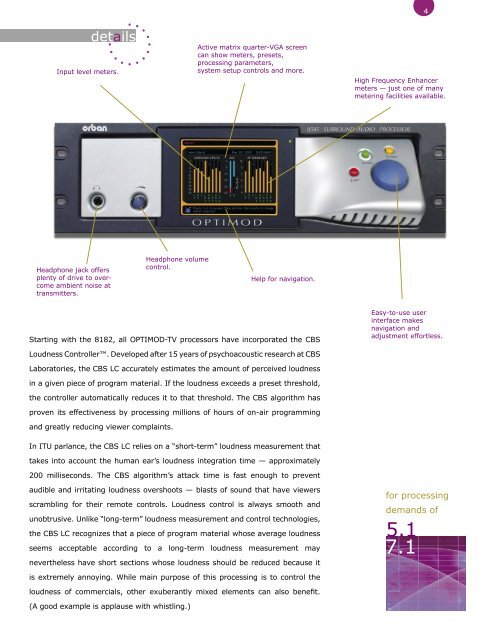om8585 brochure_r12Lo.pdf - Orban
om8585 brochure_r12Lo.pdf - Orban
om8585 brochure_r12Lo.pdf - Orban
Create successful ePaper yourself
Turn your PDF publications into a flip-book with our unique Google optimized e-Paper software.
details<br />
Input level meters.<br />
Active matrix quarter-VGA screen<br />
can show meters, presets,<br />
processing parameters,<br />
system setup controls and more.<br />
4<br />
High Frequency Enhancer<br />
meters — just one of many<br />
metering facilities available.<br />
Headphone jack offers<br />
plenty of drive to overcome<br />
ambient noise at<br />
transmitters.<br />
Headphone volume<br />
control.<br />
Help for navigation.<br />
Starting with the 8182, all OPTIMOD-TV processors have incorporated the CBS<br />
Easy-to-use user<br />
interface makes<br />
navigation and<br />
adjustment effortless.<br />
Loudness Controller. Developed after 15 years of psychoacoustic research at CBS<br />
Laboratories, the CBS LC accurately estimates the amount of perceived loudness<br />
in a given piece of program material. If the loudness exceeds a preset threshold,<br />
the controller automatically reduces it to that threshold. The CBS algorithm has<br />
proven its effectiveness by processing millions of hours of on-air programming<br />
and greatly reducing viewer complaints.<br />
In ITU parlance, the CBS LC relies on a “short-term” loudness measurement that<br />
takes into account the human ear’s loudness integration time — approximately<br />
200 milliseconds. The CBS algorithm’s attack time is fast enough to prevent<br />
audible and irritating loudness overshoots — blasts of sound that have viewers<br />
scrambling for their remote controls. Loudness control is always smooth and<br />
unobtrusive. Unlike “long-term” loudness measurement and control technologies,<br />
the CBS LC recognizes that a piece of program material whose average loudness<br />
seems acceptable according to a long-term loudness measurement may<br />
nevertheless have short sections whose loudness should be reduced because it<br />
for processing<br />
here<br />
5.1<br />
7.1<br />
demands of<br />
is extremely annoying. While main purpose of this processing is to control the<br />
loudness of commercials, other exuberantly mixed elements can also benefit.<br />
(A good example is applause with whistling.)



![[PDF] Using the ITU BS.1770-2 and CBS Loudness Meters ... - Orban](https://img.yumpu.com/50629372/1/190x245/pdf-using-the-itu-bs1770-2-and-cbs-loudness-meters-orban.jpg?quality=85)






![[PDF] Optimod-FM Feature Comparison - Orban](https://img.yumpu.com/41741615/1/190x245/pdf-optimod-fm-feature-comparison-orban.jpg?quality=85)





